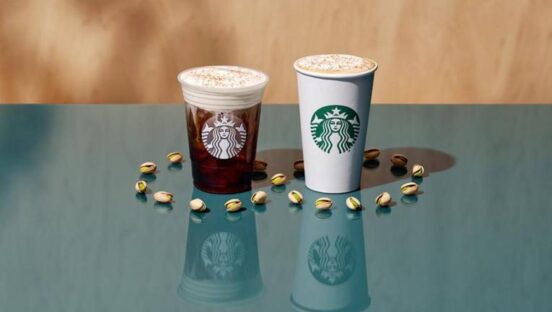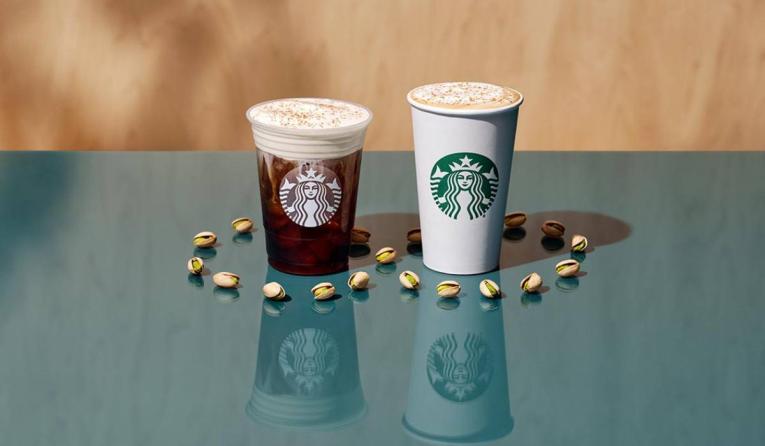On Howard Schultz’s 108th—and what he claims final—earnings call, he hinted at taking Starbucks full circle. It was 40 years ago Schultz walked the streets of Milan in one of the most well-worn origin stories in foodservice. Four decades after inspiration struck, the nearly 36,000-unit coffee shop serves 100 million customers per week.
Later this month, Schultz teased, he’s going to return to Milan and introduce “something much bigger than any new promotion or beverage.” On a trip to Italy last summer, Schultz discovered “an enduring, transformative new category and platform for the company, unlike anything I had ever experienced,” he said.
Schultz wouldn’t divulge further, only to say he’d describe it is as, “alchemy.” What a “a seemingly magical process of transformation, creation, or combination,” or a “medieval forerunner of chemistry,” has anything to do with Starbucks likely isn’t on anybody’s bingo card. “We won’t unveil details today, but it will be a game-changer, so standby,” Schultz said.
What is concrete near-term, however, is Starbucks’ business heads into a leadership change (Laxman Narasimhan is taking over as CEO in April) as a rapidly evolving organization, and one that’s generating record figures despite the fact transactions remain below pre-COVID levels. Starbucks’ North America and U.S. same-store sales increased 10 percent in Q1, driven by a 9 percent hike in average ticket and a 1 percent lift in comparable transactions, year-over-year. Starbucks’ ticket in December was the highest it’s ever been, Schultz said. In a cost-inflated climate where many consumers are trading down, and, in turn, there’s been widespread discounting, Starbucks’ loyalists aren’t pinching. Customization and how guests can create proprietary beverages are central to the brand’s value perception today, Schultz explained.
In other terms, the Starbucks guest doesn’t appear to be judging the cost of their visit by price as they might in other retail concepts; they’re paying up for a product whose value owes to exclusivity. The number of unique customers grew 10 percent in Q1, setting another banner.
This modifier conversation has pulsed all year. Modifier sales rose 28 percent in Q1, year-over-year, in U.S. company-run stores. “Showing that customers are visiting Starbucks for beverages customized to their preferences that they cannot find anywhere else,” Schultz said.
It’s a far-removed approach from the buzz-generating Unicorn Frappuccino days of old. Starbucks now is using its mobile app and ability to curate products as a way to justify the circular cost.
Additionally, it’s an angle keeping Starbucks bullish despite whatever economic turmoil awaits. If a recession does indeed take hold, CMO Brady Brewer said, the brand will lean on “momentum and innovation.”
“If we look at the last quarter, we have more customers in total population than ever in the U.S.,” he said. “They’re very highly engaged.”
“We see continued strength in our future innovation roadmap and our existing strategy around cold, customized, and plant-based beverages, and it comes down to beverages that customers love that they truly can only find at Starbucks,” Brewer added. “And that was true throughout the pandemic, and it’s true right now.”
Average weekly sales in U.S. corporate units reached a record high in Q1, beating a mark set in Q4 of the previous year. Eight of the 10 highest sales days in Starbucks’ history came this past three-month period. Revenue rose 14 percent to a quarterly high of $6.6 billion.
Active Starbucks Rewards membership in the U.S. exited Q1 over 30 million members, up four million (15 percent) over last year and 6 percent sequentially.
Starbucks’ transactions per store day, which is how it measures the health of its business, remain below 2020 trends. Yet traffic has begun to climb during peak demand, CFO Rachel Ruggeri said. The morning daypart and midday (up to 1 p.m.) witnessed a year-over-year increase in transactions and units, as well as ticket. Those dayparts are in line with 2019 levels. “So why that gives us encouragement is our reinvention plan is squarely rooted at creating capacity in our busiest dayparts,” she said. “As we start to move along our reinvention plan, it’s going to help us increase that capacity while creating a better experience for our partners and our customers. That gives us a lot of confidence that our growth objectives and our ambitions for this year and beyond are well suited.”
Returning to the strength of customization, Starbucks Reward members drove a record 56 percent of tender, 3 percent higher than last year. Mobile order and pay, drive-thru, and delivery delivered 72 percent of domestic Q1 revenue. The chain appreciated mobile order usage at 27 percent of transactions in domestic company restaurants—also a record figure. Starbucks hit an all-time high in the population of weekly total active customers and saw more than $3.3 billion loaded onto Starbucks cards in the U.S. That, too, exceeded a company record set last year.
“In fact, our gifting business was so strong that the unit sales of Starbucks Cards were greater than the next four brands of gift cards combined,” Brewer said.
The latter point not only builds reward registrations, he noted, but it also trails business forward. “Said another way, during the holiday season, Starbucks truly becomes the currency of kindness, and it drives our business,” Brewer said.
The growth of Starbucks’ rewards empire ignited, in part, a couple of years ago when the company lowered the barrier and complexity to enter. The program today is a twofold structure—product and experiential benefits. Picture Starbucks opening in the Empire State Building and allowing rewards users to visit first. Starbucks implemented changes related to reward redemption tiers on the product side. This better aligns the cost of product redemptions to current pricing, Brewer said, which creates discount efficiency and helps the company grow while effectively managing margins. Set to go into effect on February 14, it’s going to become more costly to earn many popular items and less costly to earn others.
As explained by PYMNTS, the number of rewards points, or Stars, it takes to earn brewed hot coffee, bakery items, and hot tea will double, and the number for breakfast items, specialty drinks, and packaged food items will also bump. But the number of Stars needed for iced coffee and tea and for packaged coffee will drop. Dunkin’ made a similar switch earlier in the year where a new point structure raised the bar to earn common items.
“We have an incredible roadmap ahead,” Brewer said. “So we’re just going to keep driving the program and I think our customers will have a lot to celebrate in the years ahead.”
More engagement (and sales)
Starbucks’ 6,600-plus-unit U.S. license business posted 32 percent revenue growth and double-digit comps in Q1 across all operating segments. U.S. licensed store revenue indexed at roughly 140 percent of pre-pandemic levels.
Schultz pointed out Starbucks locations in grocery retailers didn’t feel the traffic burn many big-box supermarkets highlighted of late. “Their Starbucks business proved to be the bright spot, bringing incremental traffic into their stores and driving sales for us as well,” he said.
The company continues to roll “Starbucks Connect” to these venues, which allow licensed stores to offer mobile order and pay and rewards benefits. Previously, customers couldn’t use their Starbucks profiles in these spots as they could in traditional, brick-and-mortar company builds. The flip expanded “the value offering we provide our customers and licensees and enabling us to capture demand across our broader store portfolio,” Schultz said. Its proving highly incremental, he added.
Much of Starbucks’ initiatives these days work toward the goal of streamlining engagement. The company launched a rewards integration with Delta Airlines in the quarter and introduced its “Odyssey” experience in December in beta to select users. These Odyssey members were invited to partake in Web3 technology-powered “journeys” that offer customers the chance to earn collectible “Journey Stamps,” (NFTs) and Odyssey points that open access to new benefits and immersive experiences, like a virtual tour of a coffee farm in Costa Rica.
Starbucks’ hope is the platform will create a digital community of sorts that drives loyalty through connectivity. Shortly after beta launch, members were given access to the Starbucks Odyssey market powered by Nifty Gateway, where they could buy or sell stamps among members, with Polygon as the blockchain for the entire experience.
Starbucks more recently took its partnership with DoorDash national. Coming this month, the brand will introduce a new content series in the app called, “Starbucks Daily,” which will bring customers “coffeehouse culture.”
Labor, equipment, and other happenings
With a focus on cross-functional training and a broadened suite of benefits and pay, Schultz said Starbucks experienced an 8 percent improvement in U.S. hourly retail partner turnover in the period. The number is 5 percent better than the prior year (the 8 percent measures against Starbucks’ highest-turnover stretch last year, which was Q2). Frank Britt, chief reinvention officer, who was brought on in April from workforce development firm Penn Foster, said the result “reduces the time and the investment required for additional new hires and it helps stabilize operations, and we’re now running in a pre-COVID level relative to the stores being open.”
EVP and president of Starbucks North America Sara Trilling added the brand continues to unveil equipment innovations to make work easier for employees and to drive efficiencies. And it’s getting expedited. “No more are we in a position to roll out single pieces of equipment over a multi-year time horizon,” she said. “No way, no thanks. It just can’t happen given the unbelievable demand that we’re seeing in our business.”
Thus far, Starbucks has deployed handheld order points in 54 percent of stores, cold beverage labelers in 81 percent, espresso stations in 94 percent, and new warming ovens in 90 percent. The handheld order points, in particular, are going to roll out fully this year. Similar to what guests see at Chick-fil-A and In-N-Out, the tech enables drive-thru workers to bust the line and improve uptime.
In Q1, Starbucks completed its automated ordering for food and lobby as well, which removed task time and freed up employees to focus on guest-facing tasks. “And we’ve got more in the hopper,” Trilling said. “We’re really just getting started as we look to reinvention to continue to drive throughput in our stores. And in close, I’d just say, we’ve seen all-time highs in productivity.








